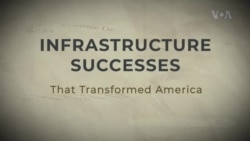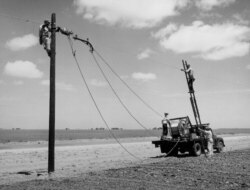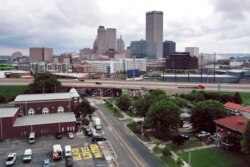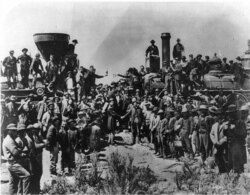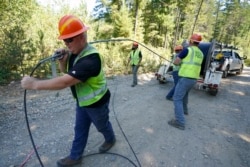Congress appears poised to pass a bipartisan, $1 trillion plan that would be the largest federal investment in infrastructure in more than a decade. History shows that investing in infrastructure can transform the United States, changing how Americans move, bolstering economic prosperity, and significantly improving the health and quality of life for many.
“When the transcontinental railroad was completed in 1869, we changed the way we moved forever, opening up the entire country and from the way humans had moved previously for thousands of years by animal to machine,” Greg DiLoreto, past president of the American Society of Civil Engineers (ASCE), told VOA via email. “[And] I think we all would agree that construction of the interstate highway system changed America in ways that greatly contributed to our economic prosperity.”
In 1956, President Dwight D. Eisenhower signed the Federal-Aid Highway Act, which authorized the building of 65,000 kilometers (41,000 miles) of interstate highways — the largest American public works program in history at the time. Another earlier transformation occurred in 1936, when Congress passed the Rural Electrification Act, extending electricity into rural areas for the first time.
And the wave of projects that created modern sewage and water systems in urban areas in the late 19th and early 20th centuries left a lasting mark, providing reliable, clean water in cities and extracting pollution from sewage.
“American cities in the late 19th, early 20th century were incredibly unhealthy places,” says Richard White, professor emeritus of American history at Stanford University in California. “High child death rates, repeated epidemics, and much of that was waterborne disease that came from both ineffective sewage and impure water. And infrastructure projects changed that dramatically. Probably it's been the most effective public health effort ever in the history of the United States.”
Dark consequences
DiLoreto also names the construction of dams across the western United States, which increased America's ability to farm and feed the world, as infrastructure successes. But he points out that the projects created problems for migrating fish. In fact, many of the so-called successful infrastructure projects, like interstate highways, had dark consequences.
“They increased racial stratification in the cities. They were built in such a way that they went through poorer neighborhoods, very often minority neighborhoods, walling them off from the city as a whole,” White says. “They set them apart and set in motion a set of social changes which we suffer from still. So, they hurt poorer areas, minority areas, even if they helped middle-class areas.”
White, who wrote the book “Railroaded,” about the building of the transcontinental railroads, contends the federal government funded too many railroads into areas without the traffic to sustain them.
“The railroads took government money and then went bankrupt,” White says. “They were very often utterly corrupt. The money was taken off into the private pockets behind some of the great fortunes in American history, and they never really delivered the economic and social benefits that they promised.”
And Native Americans ended up paying the price, White adds.
“Many of these railroads ended up costing Indian peoples huge amounts of land for no particular benefit,” he says. “It's not like white settlement was particularly successful in the land the Indians lost. So, even though it was intended to raise the standard of living for everybody in the West, it didn't necessarily do so, and the great cost was paid very often by Indian people.”
Bold enough?
The stripped-down bipartisan version of President Joe Biden’s American Jobs Plan (AJP) pours money into transportation, utilities — including high-speed internet for rural communities — and pollution cleanup. What the bill does not appear to contain is a single transformative project.
“From the information I have, funds will be used to help us repair, replace and make our infrastructure more robust to withstand climate change and seismic risks,” DiLoreto says. “One might consider that transformative in the sense that our quality of life and economic prosperity depend on a functioning infrastructure.”
White views the bill as backward-looking rather than forward-thinking at a time when the United States needs to transform itself to adjust to a changing world, doing things differently in the future than it has in the past.
“We have our first great infrastructure bill, which is mostly intended to protect things we built in the past, which, I think, in the long run, that's going to be seen as a failing,” White says. “And again, I'm not saying that you should allow bridges to fall into rivers, or that the roads don't need repair. But it's not transformative.”
There is one potentially sweeping project that could help revolutionize life in the United States.
“Broadband has had a tremendous impact on our lives,” DiLoreto says. “Without a broadband system, our ability to economically survive COVID would have been difficult.”
The current bipartisan plan provides $65 billion for broadband infrastructure.
“If broadband in this bill works as they intend it … and they bring it into poor areas which now lack broadband, that would be a good thing, that could be transformative,” White says. “That could have the same kind of consequences that rural electrification had in terms of education and lightening people's workload and allowing them to do the kinds of work they otherwise couldn't do. … But if they simply make it more effective for those who have it already, it's not going to be transformative.”





